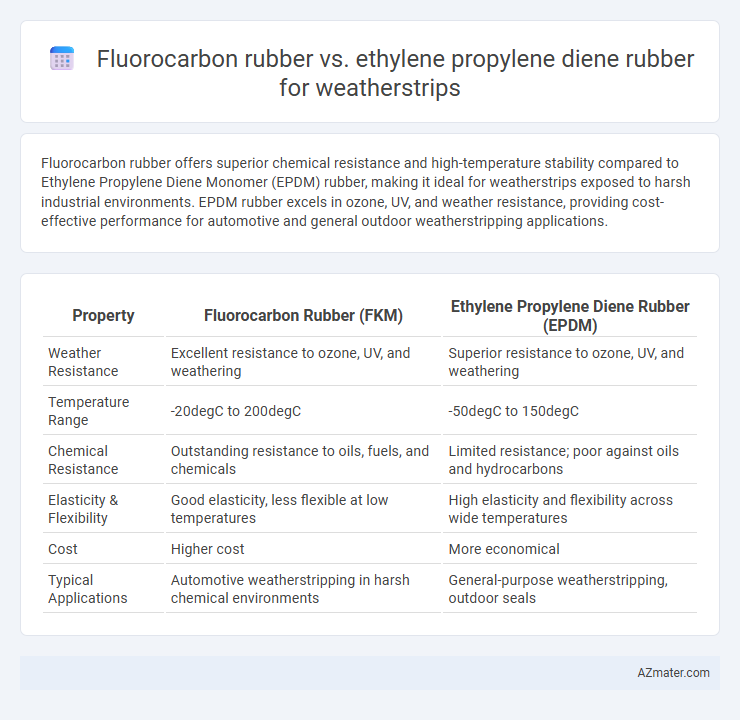Fluorocarbon rubber offers superior chemical resistance and high-temperature stability compared to Ethylene Propylene Diene Monomer (EPDM) rubber, making it ideal for weatherstrips exposed to harsh industrial environments. EPDM rubber excels in ozone, UV, and weather resistance, providing cost-effective performance for automotive and general outdoor weatherstripping applications.
Table of Comparison
| Property | Fluorocarbon Rubber (FKM) | Ethylene Propylene Diene Rubber (EPDM) |
|---|---|---|
| Weather Resistance | Excellent resistance to ozone, UV, and weathering | Superior resistance to ozone, UV, and weathering |
| Temperature Range | -20degC to 200degC | -50degC to 150degC |
| Chemical Resistance | Outstanding resistance to oils, fuels, and chemicals | Limited resistance; poor against oils and hydrocarbons |
| Elasticity & Flexibility | Good elasticity, less flexible at low temperatures | High elasticity and flexibility across wide temperatures |
| Cost | Higher cost | More economical |
| Typical Applications | Automotive weatherstripping in harsh chemical environments | General-purpose weatherstripping, outdoor seals |
Introduction to Fluorocarbon Rubber and EPDM
Fluorocarbon rubber (FKM) offers exceptional chemical resistance, high-temperature stability up to 200degC, and excellent weathering durability, making it ideal for demanding weatherstrip applications in automotive and industrial settings. Ethylene propylene diene monomer (EPDM) rubber provides superior resistance to ozone, UV rays, and water, with service temperatures ranging from -50degC to 150degC, commonly used in exterior seals and weatherstripping exposed to harsh climates. Both materials serve critical roles in weatherstripping, where FKM excels in chemical and heat resistance, while EPDM leads in environmental aging and flexibility.
Chemical Structure and Composition
Fluorocarbon rubber (FKM) consists of a polymer backbone with fluorine atoms attached, providing high resistance to chemicals, heat, and UV radiation, making it ideal for weatherstrips exposed to harsh environments. Ethylene propylene diene monomer (EPDM) rubber features a saturated hydrocarbon backbone with diene units, offering excellent resistance to ozone, water, and steam but lower chemical resistance compared to FKM. The fluorine substitution in FKM gives it superior impermeability and durability against aggressive chemicals, while EPDM's unsaturated diene component allows for efficient vulcanization and flexibility in sealing applications.
Key Performance Characteristics
Fluorocarbon rubber (FKM) offers superior chemical resistance, high-temperature stability up to 200-250degC, and excellent weathering and ozone resistance, making it ideal for weatherstrips exposed to harsh environments. Ethylene propylene diene rubber (EPDM) provides excellent resistance to UV rays, ozone, and low temperatures down to -50degC, with good flexibility and cost-effectiveness, but has limited compatibility with oils and fuels. Key performance differences include FKM's superior hydrocarbon resistance and thermal stability, whereas EPDM excels in durability against outdoor elements and cold-weather performance.
Comparative Weather Resistance
Fluorocarbon rubber (FKM) offers superior weather resistance compared to Ethylene Propylene Diene Monomer (EPDM) rubber, maintaining elasticity and strength under prolonged exposure to UV radiation, ozone, and extreme temperatures. EPDM excels in resisting ozone, steam, and heat but degrades faster than FKM when exposed to hydrocarbons, oils, and aggressive environmental chemicals. For weatherstrips used in outdoor automotive and industrial applications, FKM delivers longer service life and better performance in harsh climates where chemical exposure is significant.
Temperature Tolerance and Heat Aging
Fluorocarbon rubber (FKM) exhibits superior temperature tolerance, typically withstanding continuous exposure up to 200-250degC and short-term peaks up to 300degC, making it ideal for high-heat weatherstrip applications. Ethylene propylene diene rubber (EPDM) offers good heat resistance but generally tolerates continuous temperatures only up to 150-160degC and shows faster degradation under prolonged heat aging conditions. The exceptional heat aging resistance of fluorocarbon rubber ensures longer service life in extreme thermal environments compared to EPDM, which can become brittle and lose elasticity with extended heat exposure.
Resistance to Oils and Chemicals
Fluorocarbon rubber exhibits superior resistance to oils, fuels, and a wide range of chemicals, making it ideal for weatherstrips exposed to harsh chemical environments and hydrocarbon-based fluids. Ethylene propylene diene rubber (EPDM) offers excellent resistance to water, steam, and polar substances but performs poorly against oils and hydrocarbons, limiting its use in oil-exposed applications. Choosing fluorocarbon rubber for weatherstrips ensures extended durability and chemical resilience in demanding conditions involving oils and aggressive chemicals.
Flexibility and Compression Set
Fluorocarbon rubber (FKM) offers superior flexibility and maintains excellent compression set resistance under high temperatures and chemical exposure, making it ideal for weatherstripping in harsh environments. Ethylene propylene diene rubber (EPDM) provides good flexibility and outstanding compression set retention in low-temperature and outdoor weathering conditions, ensuring durable sealing performance. Selecting between FKM and EPDM depends on the specific temperature range and chemical exposure requirements of the weatherstrip application.
Typical Applications in Weatherstripping
Fluorocarbon rubber (FKM) is widely used in weatherstripping applications requiring exceptional resistance to chemicals, high temperatures, and ultraviolet (UV) exposure, such as automotive seals and aerospace components. Ethylene propylene diene monomer (EPDM) rubber excels in outdoor weatherstripping due to its superior resistance to ozone, weathering, and water, making it ideal for window seals, door gaskets, and HVAC systems. Both materials provide durable sealing solutions, but FKM is preferred in harsh chemical environments while EPDM dominates general-purpose weatherstripping with excellent environmental resilience.
Cost Comparison and Availability
Fluorocarbon rubber (FKM) generally has a higher initial cost compared to Ethylene Propylene Diene Monomer (EPDM) rubber due to its superior chemical resistance and temperature stability, making it suitable for high-performance weatherstripping applications. EPDM rubber offers lower cost and widespread availability, making it the preferred choice for general-purpose weatherstrips in automotive and construction industries. While FKM provides enhanced durability and longer service life under harsh conditions, EPDM's cost-effectiveness and ease of procurement make it a practical option for budget-conscious projects.
Choosing the Right Rubber for Weatherstrip Needs
Fluorocarbon rubber offers superior resistance to high temperatures, chemicals, and UV exposure, making it ideal for weatherstrips exposed to harsh environmental conditions. Ethylene propylene diene rubber (EPDM) excels in flexibility, ozone resistance, and affordability, suitable for general-purpose weatherstripping in moderate climates. Selecting the right rubber for weatherstrip needs depends on application-specific factors such as temperature range, chemical exposure, and budget constraints.

Infographic: Fluorocarbon rubber vs Ethylene propylene diene rubber for Weatherstrip
 azmater.com
azmater.com